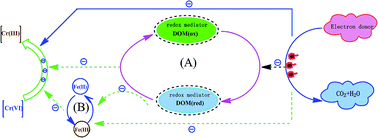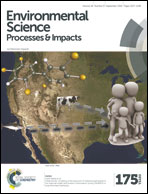Enhanced biotic and abiotic transformation of Cr(vi) by quinone-reducing bacteria/dissolved organic matter/Fe(iii) in anaerobic environment
Abstract
This study investigated the simultaneous transformation of Cr(VI) via a closely coupled biotic and abiotic pathway in an anaerobic system of quinone-reducing bacteria/dissolved organic matters (DOM)/Fe(III). Batch studies were conducted with quinone-reducing bacteria to assess the influences of sodium formate (NaFc), electron shuttling compounds (DOM) and the Fe(III) on Cr(VI) reduction rates as these chemical species are likely to be present in the environment during in situ bioremediation. Results indicated that the concentration of sodium formate and anthraquinone-2-sodium sulfonate (AQS) had apparently an effect on Cr(VI) reduction. The fastest decrease in rate for incubation supplemented with 5 mM sodium formate and 0.8 mM AQS showed that Fe(III)/DOM significantly promoted the reduction of Cr(VI). Presumably due to the presence of more easily utilizable sodium formate, DOM and Fe(III) have indirect Cr(VI) reduction capability. The coexisting cycles of Fe(II)/Fe(III) and DOM(ox)/DOM(red) exhibited a higher redox function than the individual cycle, and their abiotic coupling action can significantly enhance Cr(VI) reduction by quinone-reducing bacteria.


 Please wait while we load your content...
Please wait while we load your content...